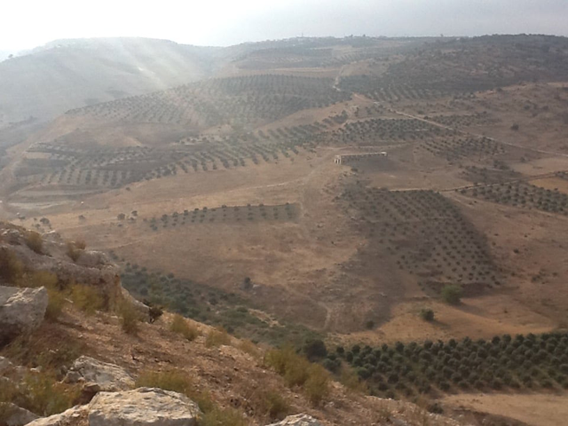You are here
Neolithic mega sites of Jordan: Focusing on pottery from Tell Abu Suwwan
By Saeb Rawashdeh - Feb 15,2024 - Last updated at Feb 15,2024

The Neolithic site Tell Abu Suwwan located near Jerash (Photo courtesy of University of Jordan)
AMMAN — Located some 500 metres from the old Amman-Jerash road, Tell Abu Suwwan represents one of the Neolithic mega sites whose occupation goes back to Pre-Pottery Neolithic period. Today, the area is used for agriculture and this extensive work on the land destroyed the archaeological layers.
“The Neolithic village was established in the Wadi Zarqa basin,” noted Zeidan Kafafi, adding that several other Neolithic villages were established in this basin, such as ‘Ain Ghazal, eh-Sayyeh and Abu Thawwab. This high occupation density suggests intensive settlement during the Neolithic period while archaeological data from Tell Abu Suwwan suggest that it was linked to both the Jordan Valley and other sites in the highland, as well as the Jordanian Badia.
“The excavators of the Wisad site in the Badia uncovered typical Yarmoukian flint tools and a single Yarmoukian pottery sherd decorated with herring-bone incision,” Kafafi continued, adding that Diana Kirkbride (1915-1997) recognised two main occupational periods at the site: the Paleolithic and the Pre-Pottery Neolithic. After that, the site has been revisited by several scholars, but no excavations were carried out until 2005.
The University of Jordan conducted five seasons of regular excavations in the period from 2005 to 2008, led by Maysoon Nahar.
“Tell Abu Suwwan, the Neolithic village, was first established during the last phase of the Middle Pre-Pottery Neolithic B [ca. 8,250-7,500BC],” Nahar said, adding that it seems that the Neolithic village flourished during the Late Pre-Pottery Neolithic B (PPNB) (ca. 7,500-7,000BC-Yarmoukian period).
During this period, the inhabitants of Tell Abu Suwwan had their own distinct architectural types and a unique squared grilled building type has been uncovered, Kafafi continued, adding that this structure has been constructed during the Middle PPNB.
“It was modified gradually and used all through the Neolithic occupation at the site. The building was abandoned by the end of the Late Neolithic ‘Yarmoukian Culture’ in [ca. 6,000BC], Nahar explained, noting that the gradual process of the Neolithic development in the Ancient Near East has previously been divided into Pre-Pottery and Pottery Neolithic and, in some other cases, into Early and Late Neolithic, and Aceramic and Ceramic.
Nevertheless, the Pottery Neolithic period, which has been characterised by the production of clay vessels in the southern Levant, includes several traditions such as the Yarmoukian, Pottery Neolithic A, and the Ghrubba, assigned to a period ranging from ca. 5.600-5,000BC, the Wadi Rabbah and Jericho Pottery Neolithic B attributed to a period from ca. 5,000-4,500BC, Nahar underlined.
Meanwhile, the terms Yarmoukian and Wadi Rabah are cultural terms and the first is contemporaneous with civilisations from Jericho.
“Excavations at Tell Abu Suwwan yielded a total of 488 pieces of Yarmoukian pottery. The sample under study includes 86 Yarmoukian pottery sherds that came from in situ contexts traceable to the Yarmoukian period/culture,” Nahar said, adding that several studies discussed Yarmoukian pottery assemblages from other sites in the southern Levant.
Wadi Zarqa is an area with many sites from the Yarmoukian period; scholars found a large number of pottery from this period, unlike the Black Desert in the northeast of Jordan. However, there is evidence of exchange of goods and pottery between the central massive and the Black Desert.
The quantities of the Yarmoukian pottery sherds in the above mentioned sites indicate that pots were probably produced at individual sites. However, the notion that there might have been a centre of Yarmoukian pottery production in the Wadi Zarqa during the Late Neolithic is still under consideration, Kafafi noted.
The archaeological evidence from the Abu Suwwan excavations proved that the site underwent very important developments from the Middle PPNB through the end of the Pottery Neolithic/Late Neolithic, Nahar said, adding that the burned sediments and the availability of number of pits at the site in both areas combined with the large number of sherds suggest that the site might have used pottery kiln/s during the Yarmoukian period.
“Unfortunately, the cultivation activities in the top layer may have destroyed these features. The possibility of finding a clear pottery kiln is a possibility and will be the focus of future excavation seasons,” Kafafi concluded.
Related Articles
AMMAN — Excavations at the Tell Rakan archaeological site are contributing to a better understanding of Neolithic settlements in northern Jo
AMMAN — Evidence of human occupation in wadis from the Jordanian central massive goes back to the Palaeolithic period as it was evidenced in
AMMAN — Wadi Rum is a desert on the southern part of Jordan also known the Valley of Moon.


















